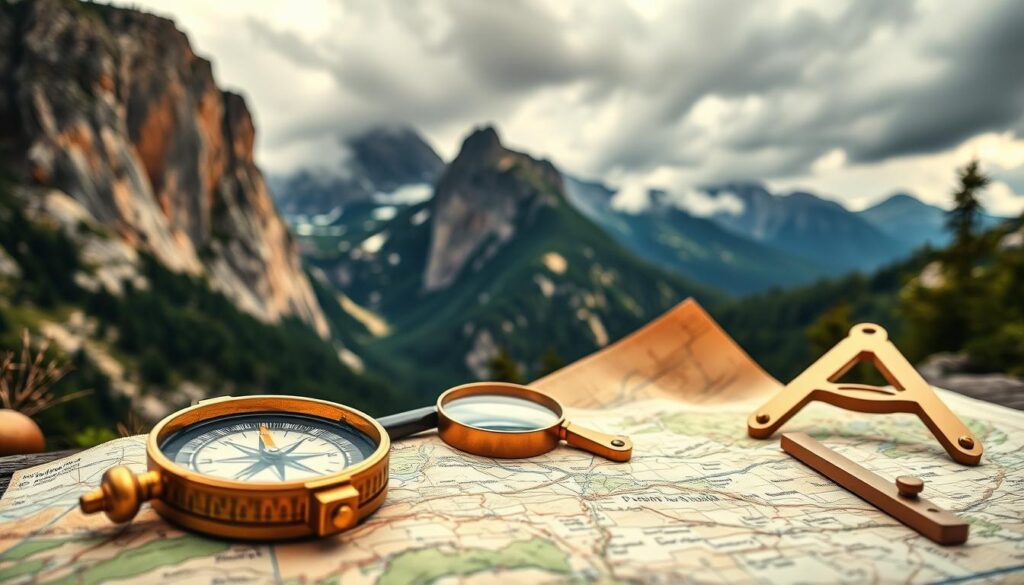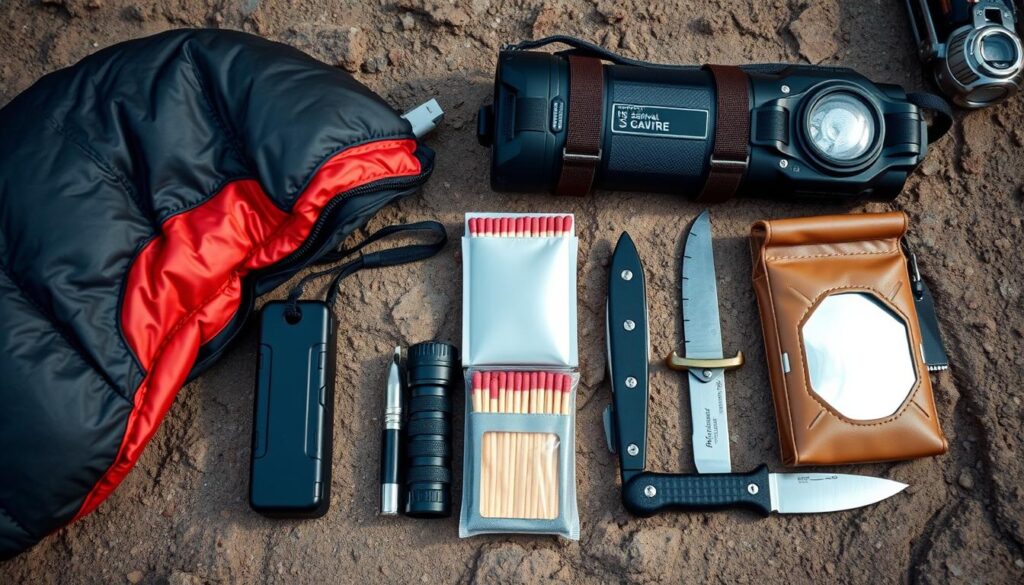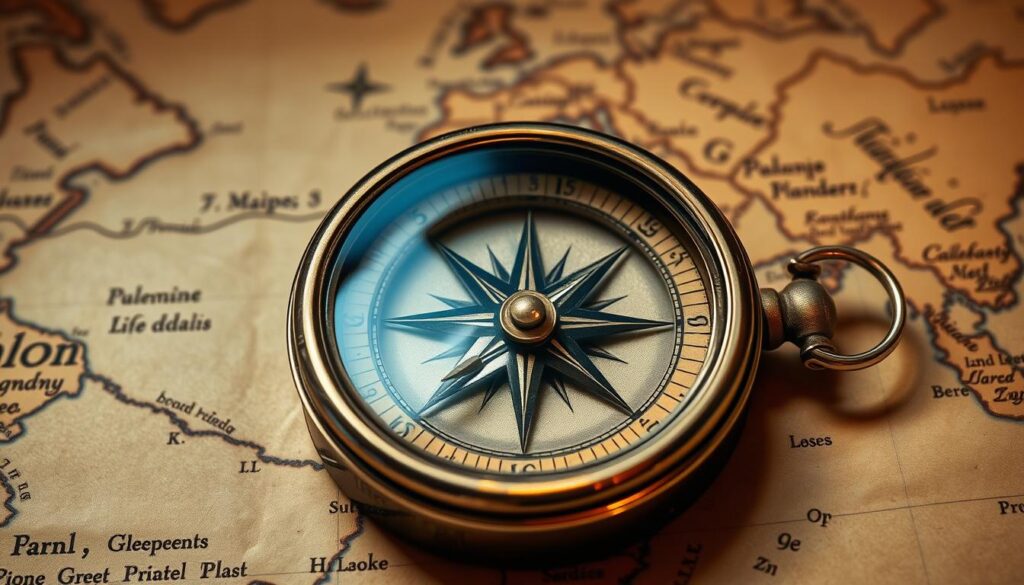Learning to use a compass has changed my hiking game. It has opened up new paths and improved my navigation.
If you love exploring off the beaten path, knowing how to use a navigation tool like a compass is key. It helps find magnetic north, which is vital for navigating right. For more tips, check out American Hiking or Survivalist Bottles.
Key Takeaways
- Understand the basics of a compass and its importance in navigation.
- Learn how to identify magnetic north and its difference from true north.
- Discover how to use a compass for orienteering and hiking.
- Explore resources for improving your navigation skills.
- Enhance your outdoor adventures with effective navigation techniques.
Understanding the Basics of a Compass
As I start learning about navigation, I first need to understand a compass. A compass is a basic tool for hikers. It doesn’t need batteries, works with any map, and can even guide without a map!
A compass has been guiding people for centuries. It’s a simple tool that shows direction. This helps users find their way in unknown places.
What is a Compass?
A compass is a key tool for finding direction. It aligns with the Earth’s magnetic field. The main part of a compass is the magnetic needle. It points towards the Magnetic North because it’s balanced on a pivot.
How Does a Compass Work?
A compass works by aligning its magnetic needle with the Earth’s magnetic field. The Earth’s core moves molten iron, creating this field. This field makes the compass needle point towards the Magnetic North.
It’s important to know that Magnetic North is not the same as True North. True North is the direction to the geographical North Pole. The difference between them is called declination. Knowing this is key for accurate navigation.
- The magnetic needle is balanced on a pivot, allowing it to rotate freely.
- The Earth’s magnetic field causes the needle to point towards Magnetic North.
- Understanding declination is key to using a compass effectively.
By understanding how a compass works and what it is, I can use it for navigation. This basic knowledge is vital for any adventurer or hiker who relies on a compass.
Types of Compasses I Can Use
When I head into the wilderness, knowing about different compasses is key. The right one can greatly help me navigate unknown areas.
Compasses vary, each for different needs and activities. Some are made for orienteering, while others are better for hiking or geocaching.
Magnetic Compasses
Magnetic compasses are very common. They work by following the Earth’s magnetic field, helping me find direction. They’re great for hiking and backpacking because they’re easy to use and work well.
One important feature of magnetic compasses is their declination adjustment. Some models have an outer degree ring that can be adjusted. This is helpful for accurate navigation.
“A good compass is like a good friend; it always points you in the right direction.” – Anonymous
Topographic Compasses
Topographic compasses are for more advanced navigation. They have features good for orienteering and geocaching. These compasses have a rotating bezel and a base plate with a ruler, making them useful for complex terrain.
They’re best when used with a topographic map. They help me orient and measure distances and angles. This makes navigating tough areas easier.
| Compass Type | Primary Use | Key Features |
|---|---|---|
| Magnetic Compass | Hiking, Backpacking | Simple, Reliable, Declination Adjustment |
| Topographic Compass | Orienteering, Geocaching | Rotating Bezel, Ruler, Precise Orientation |
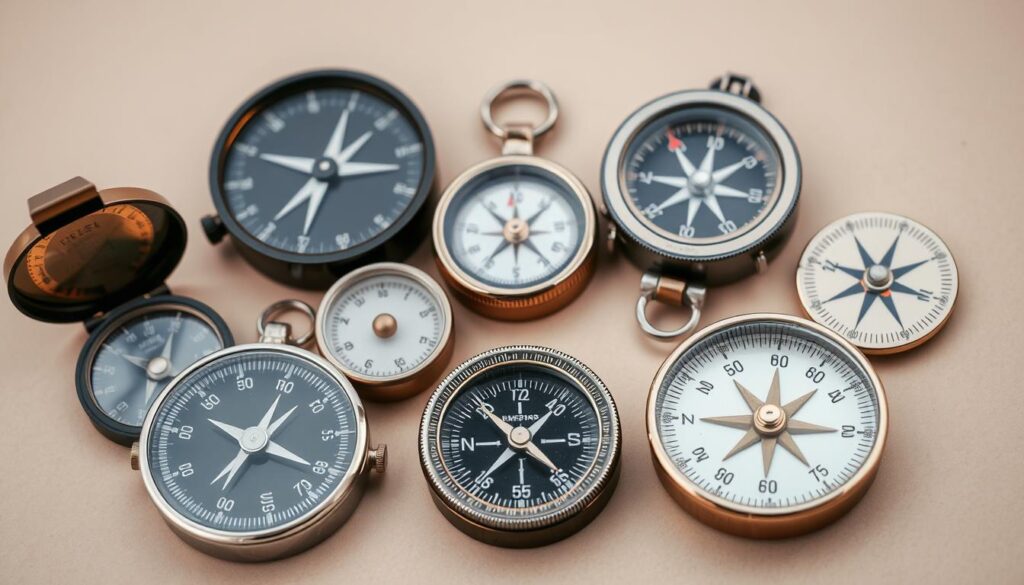
In conclusion, choosing the right compass depends on the activity and needed precision. Knowing about the different types helps me pick the best one for my navigation needs.
Parts of a Compass I Need to Know
To use a compass well, knowing its parts is key. A compass helps find direction and has important parts like the magnetic needle, base plate, and direction-of-travel arrow. Knowing these parts helps navigate accurately.
Exploring compass navigation, I found a compass has many features. These include the base plate, compass dial, magnetic needle, compass lines, orienting arrow, direction of travel arrow, index line, and map scales. Knowing these parts is essential for good navigation.
Magnetic Needle
The magnetic needle is vital in a compass. It shows direction by aligning with Earth’s magnetic field. The needle is red at one end, pointing to the north pole. It’s balanced to rotate freely.
I’ve learned the magnetic needle is affected by metal or electronic devices. This can mess with its accuracy.
Base Plate
The base plate is the compass’s foundation. It holds the compass dial and magnetic needle. It’s usually clear plastic and has direction-of-travel arrows and other marks for navigation.
Direction-of-Travel Arrow
The direction-of-travel arrow shows the way to go. It’s on the base plate and works with the magnetic needle. For more on using a compass, check out this guide on crafting the ultimate bug-out bag.
| Compass Part | Description |
|---|---|
| Magnetic Needle | Indicates direction by aligning with the Earth’s magnetic field |
| Base Plate | Provides a stable platform for the compass dial and magnetic needle |
| Direction-of-Travel Arrow | Indicates the direction to head in |
“A good navigator never underestimates the importance of understanding their compass.”
Reading a Compass: My Step-by-Step Guide
Learning to read a compass is key for effective navigation. With practice, using a compass becomes easy. This lets you enjoy the journey more. Here, I’ll show you how to read a compass, from finding magnetic north to following a bearing.
Finding Magnetic North
To start, find magnetic north. Hold the compass level and adjust the bezel until the arrow points to your destination. The magnetic needle will point to the magnetic north, shown by the red end. Remember, magnetic north is not the same as true north, which is towards the Earth’s North Pole.
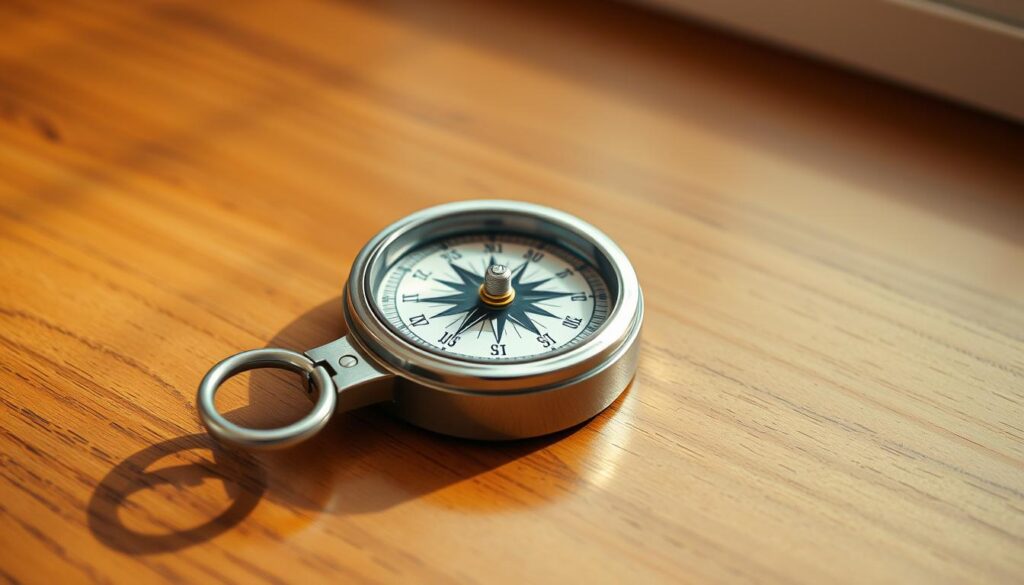
Setting a Bearing
After finding magnetic north, set your bearing. Turn the bezel until the arrow points in your direction. The bearing is the angle from magnetic north to your path, in degrees. For example, heading east means a 90-degree bearing. Make sure the compass is level and the bezel locked to keep your bearing.
Following a Bearing
Now, follow your bearing to your destination. Hold the compass in front of you, with the arrow pointing away. Keep it level and the magnetic needle aligned with the bezel’s magnetic north indicator. As you move, check your bearing often to stay on course. If you’re off track, adjust your direction to get back on course.
To know your direction, hold the compass in front of you with the arrow pointing the way you’re walking. Then, rotate the dial so the N aligns with the red needle. By following these steps, you’ll navigate confidently, using your compass to guide you.
Using a Compass for Hiking Adventures
When I go hiking, a compass is essential. It helps me find my way in new places and keeps me on course.
Choosing the Right Trail
First, I pick the right trail. My compass guides me in the right direction. By matching the compass with the map, I find the safest path. A good trail choice can turn a hike into a fun adventure.
Navigating with Landmarks
I use landmarks to guide me as I hike. These can be rivers, mountains, or unique rocks. My compass helps me stay on track by taking bearings on these landmarks. This method is great when it’s hard to see or the trail is hard to follow.
Adjusting for Declination
Using a compass means adjusting for declination. Declination is the difference between magnetic and true north. I check the map’s legend for this info. Adjusting for declination makes sure I navigate correctly.
Combining a Compass with a Map
To navigate well, I must learn to use a compass with a map. This skill is key for orienteering and other navigation tasks. Together, these tools help me find my location and direction.

First, I need to get to know topographic maps. These maps show the Earth’s surface in detail. They use symbols, scales, and contour lines to show elevation changes. Knowing these helps me use the map with my compass.
Understanding Topographic Maps
Topographic maps are full of information. They use symbols and colors for different features. For example, contour lines show terrain shape and elevation. It’s important to know these symbols and the map’s scale for good navigation.
- Contour lines indicate elevation changes.
- Symbols represent features like rivers, buildings, and roads.
- The map’s scale provides a ratio of distance on the map to real-world distance.
Plotting a Course
After getting the hang of topographic maps, I can plan a route. I lay the map flat and put my compass on it. Then, I turn the map until the compass needle matches the map’s gridlines. This makes sure the map is aligned with the Earth’s magnetic field.
- Lay the map flat.
- Place the compass on the map.
- Align the compass needle with the map’s gridlines.
Identifying My Current Location
To find where I am, I look for landmarks on the map that I see around me. By matching what’s on the map to what I see, I can find my exact spot. This method uses both the map and compass to check my surroundings.
Using a compass with a map is a great navigation tool. It helps me navigate, even in places I don’t know well. This combo is also useful for geocaching, where you need to be very precise.
Compass Maintenance Tips I Live By
To keep my compass reliable, I maintain it regularly. A well-kept compass is key for accurate navigation in the wild. Here, I’ll share my best tips for keeping your compass in great shape.
Keeping your compass clean and stored right is more than just a task. It’s about ensuring it works well for your outdoor adventures. I’ll guide you through cleaning and storing your compass right.
Cleaning My Compass
Cleaning my compass is easy but needs care. I start by wiping it with a soft cloth to remove dirt. For a deeper clean, I dampen the cloth but avoid getting water inside.
Key Cleaning Tips:
- Use a soft, dry cloth to wipe down the compass.
- Dampen the cloth if necessary, but avoid exposing the compass to excessive moisture.
- Pay special attention to the bezel and dial, as these areas can accumulate dirt and grime.
Storing a Compass Properly
Storing my compass right is as important as cleaning it. I keep it away from extreme temperatures and magnets. When not in use, I store it in a protective case to protect it from dust and damage.
Storage Best Practices:
| Storage Method | Benefits |
|---|---|
| Protective Case | Prevents physical damage and dust accumulation |
| Avoiding Magnetic Sources | Reduces the risk of magnetic interference |
| Stable Temperature | Ensures the compass’s internal mechanisms remain stable |
By following these simple tips, I trust my compass for accurate readings. Whether hiking or navigating cities, my compass is essential for my adventures.
Real-Life Navigation Scenarios
In different places, like wilderness trails and city streets, a compass is very helpful. It’s a key tool for orienteering and keeping on track.
Urban Navigation
Using a compass in cities is simple but needs careful attention. I use it to figure out directions and match up with the city’s grid. This is really useful when I’m in new areas or my phone isn’t working.
To navigate cities, I align my compass with the grid. The direction-of-travel arrow guides me. This helps me understand the city’s layout and move around better.
Wilderness Navigation
In the wild, a compass is essential for hiking and trekking. It helps me find my way, even when there are no landmarks. With a map, I can navigate through tough terrains.
I also use triangulation to find my spot in the wilderness. By spotting two landmarks on the ground and my map, I can guess where I am. This is helpful when I’m not sure exactly where I am.
Emergency Situations
In emergencies, a compass can save lives. It helps me find my way back to safety when I’m lost or confused. I set a bearing and follow it to increase my chances of being found.
In emergencies, staying calm and using my compass well is key. I remember a time when a storm hit while I was hiking. My compass helped me find my way back to the trailhead.
Troubleshooting Common Compass Issues
A compass can sometimes be tricky, even though it’s simple. Knowing how to fix common problems is key for good navigation.
Magnetic Interference
Magnetic interference is a big problem for compass accuracy. It can come from metal objects, electronic devices, or certain rocks. To avoid this, I keep my compass away from magnets.
For example, near cars or power lines, the compass needle can be off. I look for a spot that’s far from these magnets. Also, checking for metal on me or in my stuff helps prevent issues.
Calibration Problems
Calibration issues can mess with a compass’s accuracy. I follow the maker’s guide to calibrate mine. This usually means rotating it to match the Earth’s magnetic field.
If calibration is a problem, I make sure my compass is level and away from magnets. For tricky calibrations, I look up a detailed guide on fixing compasses.
Aging Compasses
Compasses can wear out over time, with issues like a bad magnetic needle or a broken dial. Regular checks help keep mine working well. I look for signs of wear often.
If I spot problems, like a slow needle or wrong readings, I might replace it. For activities like geocaching, a good compass is vital. So, I keep mine in top shape.
Continuing My Compass Education
I’m always looking to improve my navigation skills. Learning more about the Compass and its uses in orienteering, outdoor activities, and geocaching is key. I’m exploring different resources to learn more about this essential tool.
Recommended Resources and Books
For a deeper dive into navigation, I suggest checking out books on orienteering and geocaching. The National Wildfire Coordinating Group website is also a great resource. It offers insights into magnetic declination and Compass use. These resources will help me get better at using a Compass for outdoor activities.
Joining Navigation Clubs or Classes
Joining navigation clubs or classes is another great way to learn. I can meet experienced navigators and get hands-on experience at orienteering events. This will help me become more confident in using a Compass outdoors.
FAQ
What is the difference between magnetic north and true north?
Magnetic north is where the Earth’s magnetic field lines point. True north is the direction to the Earth’s North Pole. Knowing this helps you navigate better.
How do I choose the right compass for my outdoor activities?
The compass you need depends on your activity. For hiking and orienteering, a magnetic or topographic compass works well. A digital compass is better for geocaching.
What are the essential parts of a compass?
A compass has a magnetic needle, base plate, and direction-of-travel arrow. Knowing these parts is key for navigation.
How do I adjust for declination when using a compass?
Declination is the difference between magnetic and true north. To adjust, set your compass to account for this difference. This ensures you navigate accurately.
Can I use a compass without a map?
You can use a compass alone, but using a map is better. A map gives context and helps you understand where you are.
How do I maintain my compass?
Keep your compass clean and store it right. Avoid extreme temperatures and magnetic fields to keep it working well.
What are some common issues that can affect compass accuracy?
Issues like magnetic interference, calibration problems, and aging can affect accuracy. Knowing these can help you fix problems.
Can I use a compass in urban areas?
Yes, a compass is useful in cities, with a map. It helps navigate unfamiliar cities or complex urban areas.
Are there any recommended resources for learning more about compass navigation?
Yes, many resources are available. Books, navigation clubs, and classes can help improve your skills.

